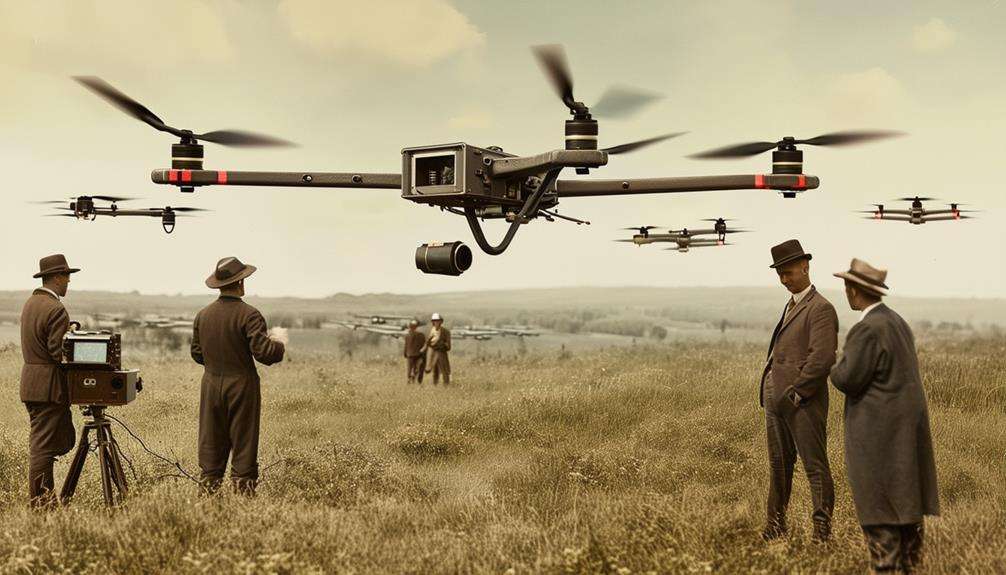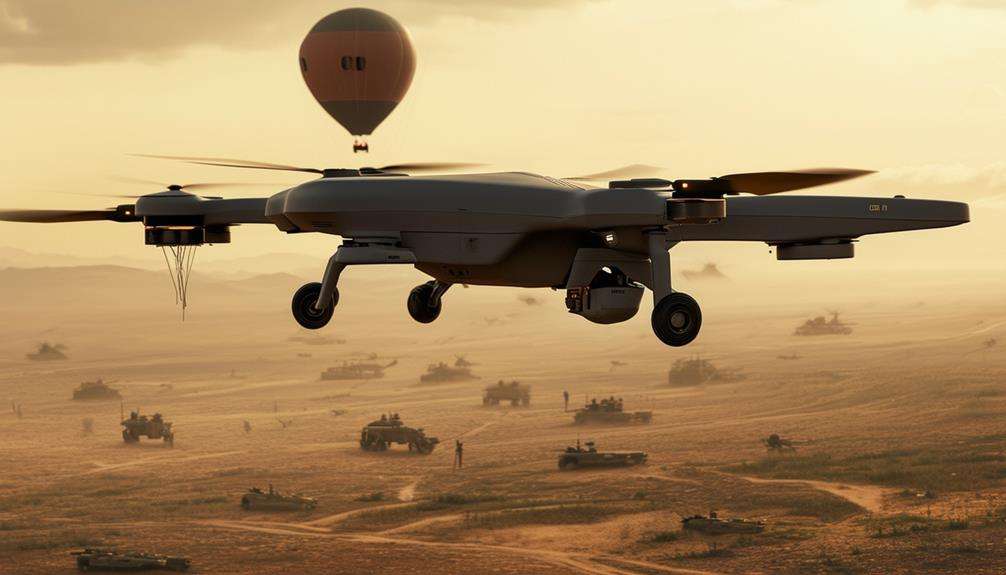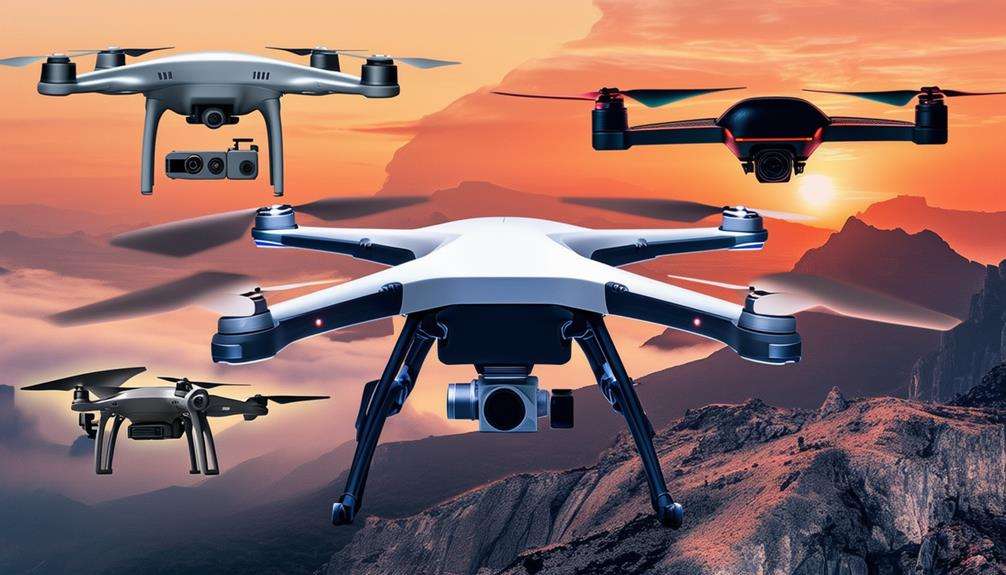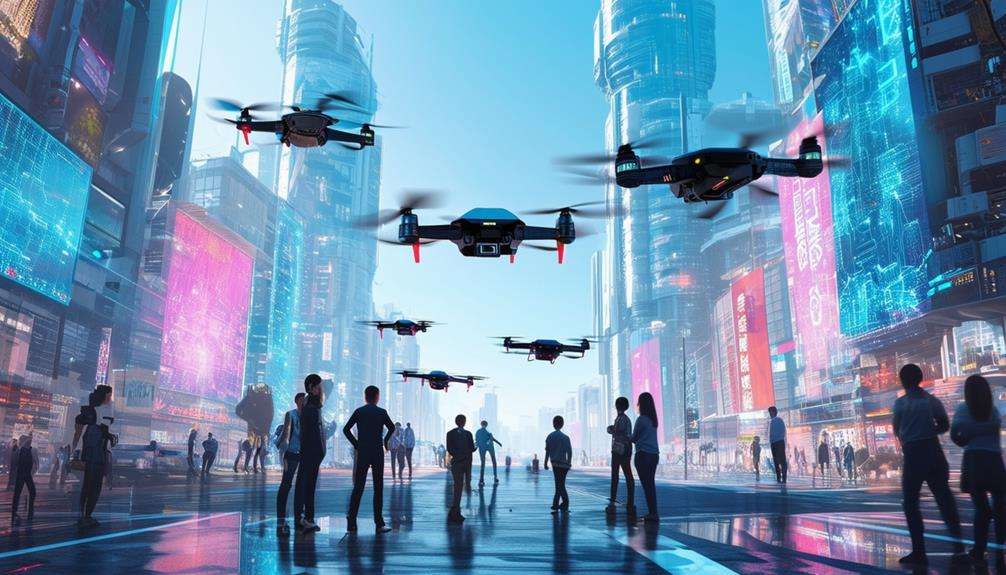Fixed-Wing Vs. Rotary-Wing Drones: What’S the Difference?
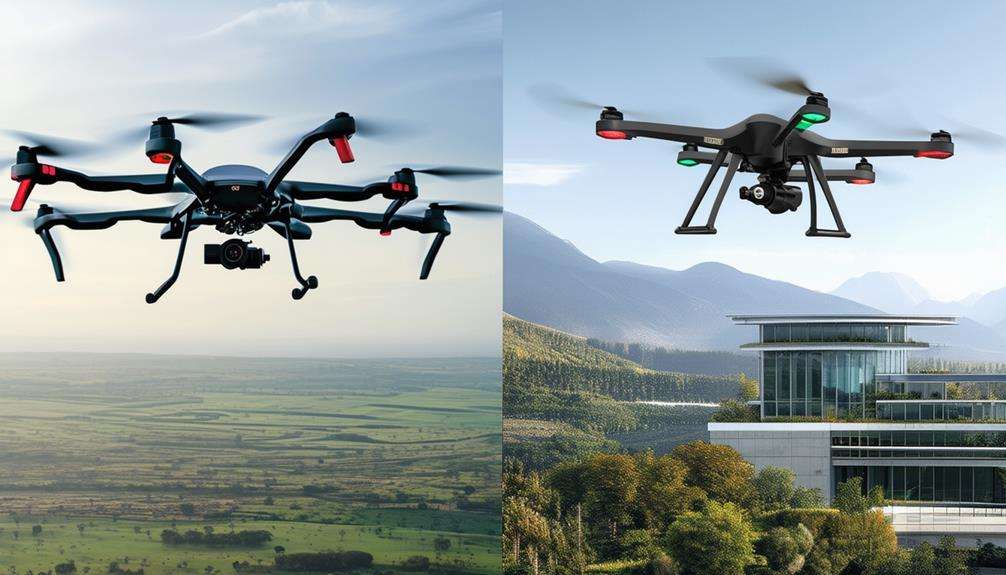
When you think of drones, you might picture a quadcopter hovering in place or an airplane-like device gliding through the sky. Both fixed-wing and rotary-wing drones have unique strengths and weaknesses that distinguish them. Fixed-wing drones are designed for aerodynamic efficiency and long-range capabilities, making them ideal for extensive mapping missions. On the other hand, rotary-wing drones are known for their precision and maneuverability, making them perfect for up-close inspections and detailed photography. How do these differences impact their practical applications and overall performance? Let's explore further to determine which type might best suit your needs.
Understanding Fixed-Wing Drones
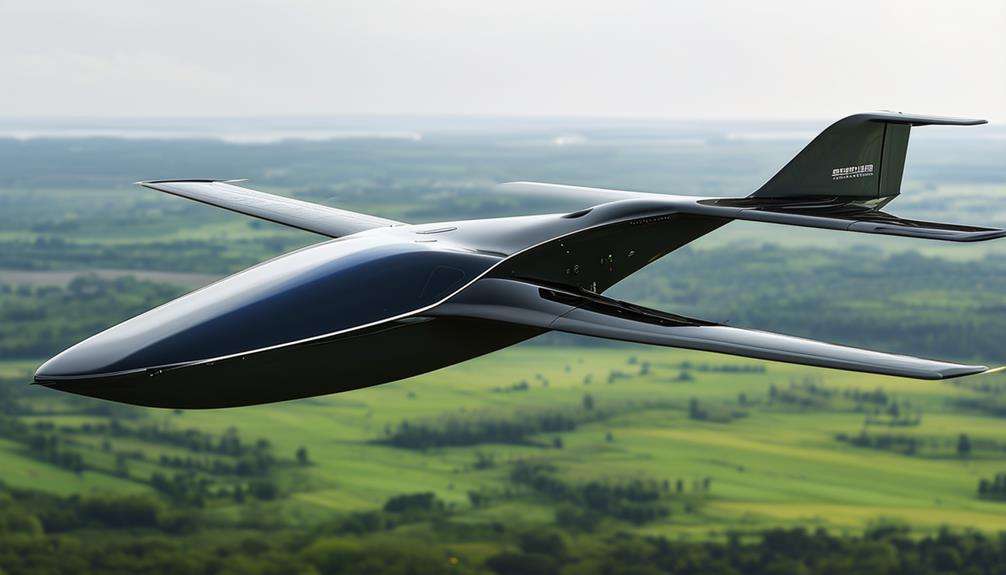
Fixed-wing drones, resembling traditional airplanes with rigid wings, offer exceptional energy efficiency and endurance. Engineered for long flight durations, they're ideal for tasks requiring extended periods in the air, such as aerial mapping and agricultural monitoring. Their ability to cover vast areas without frequent recharges is a significant advantage.
A key feature of fixed-wing technology is its aerodynamic efficiency. Unlike rotary-wing drones, fixed-wing models glide through the air, requiring less energy to stay aloft. However, they need a runway-like area for takeoff and a controlled space for landing. This requirement might limit their use in confined environments, but the benefits often outweigh this limitation.
Additionally, fixed-wing drones have higher payload capacities, enabling them to carry sophisticated equipment such as high-resolution cameras and advanced sensors. This makes them perfect for detailed aerial mapping and surveying. The combination of long flight times and substantial payload capacity ensures that fixed-wing drones are powerful tools for a range of industrial applications, from agriculture to security.
Exploring Rotary-Wing Drones
Rotary-wing drones, including quadcopters and hexacopters, are celebrated for their exceptional maneuverability and vertical takeoff and landing (VTOL) capabilities. These drones utilize multiple vertical propellers to generate lift, enabling precise hovering, ascending, and descending. This makes them ideal for operation in confined spaces and on uneven terrains where traditional fixed-wing drones would struggle.
For aerial photography enthusiasts, rotary-wing drones are the preferred choice. Their ability to hover steadily provides an excellent platform for capturing stunning images and videos. Quadcopters and hexacopters are also indispensable for tasks requiring close-proximity navigation, such as inspections and detailed surveys.
However, rotary-wing drones do have limitations. They typically carry smaller payloads compared to fixed-wing models. Additionally, their stability can be compromised in windy conditions, often necessitating active stabilization systems to maintain control. Despite these challenges, their agility and precision often outweigh these drawbacks, making them a versatile tool for various applications.
Design and Structure
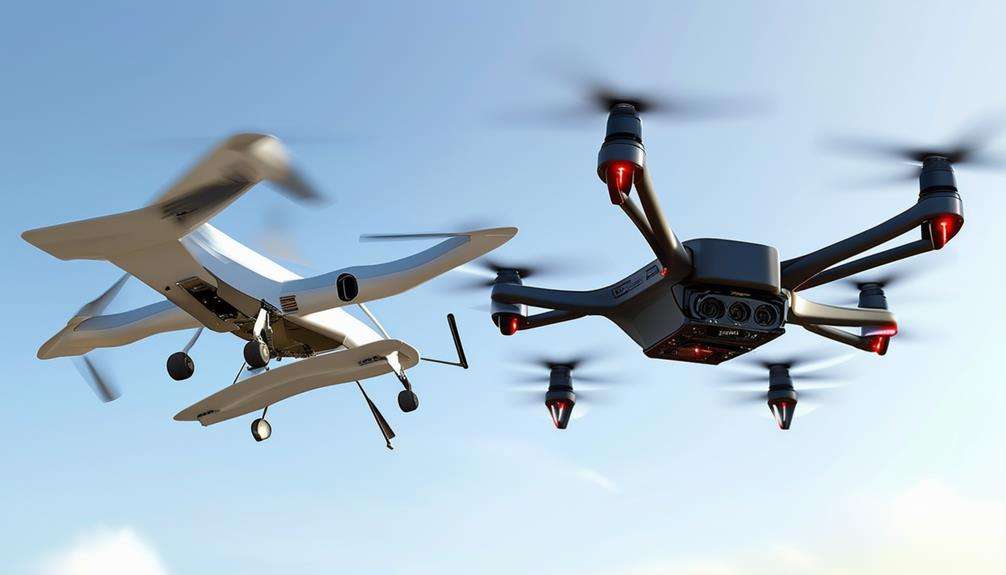
When evaluating the design and structure of drones, you'll observe that fixed-wing models feature a rigid wing structure similar to airplanes, which optimizes for aerodynamic efficiency and stability.
In contrast, rotary-wing drones use multiple vertically oriented propellers, providing exceptional maneuverability and the capability for vertical takeoff and landing. Understanding these aerodynamic properties and structural elements is crucial for selecting the right drone to meet your specific requirements.
Aerodynamic Characteristics
To understand the aerodynamic characteristics of drones, it's crucial to examine their design and structural elements. Fixed-wing drones, similar to traditional airplanes, utilize rigid wings to generate lift by moving through the air. This design affords them exceptional flight efficiency, making them suitable for long-duration missions. Their aerodynamic properties favor stability and streamlined motion, allowing them to cover extensive distances with minimal energy consumption.
Conversely, rotary-wing drones employ multiple vertically oriented propellers to produce lift and thrust. This configuration enables vertical takeoff and landing, making them highly maneuverable and capable of hovering in place. Although they may not match the flight efficiency of fixed-wing drones, their proficiency in performing close-quarter tasks and precise movements is unparalleled.
The design differences between fixed-wing and rotary-wing drones significantly impact their aerodynamic characteristics. Fixed-wing drones are optimized for stable, long-range flights, while rotary-wing drones excel in maneuverability and versatility in confined spaces. Understanding these distinctions is essential for selecting the appropriate drone type for specific applications, whether for surveying vast landscapes or conducting detailed inspections in tight areas.
Structural Components
Fixed-wing drones have a design akin to traditional airplanes, featuring a single rigid wing that provides both lift and stability. This design facilitates efficient gliding and enables these drones to cover long distances with minimal energy consumption. However, the requirement for a runway-like area for takeoff and landing can limit their operational environments.
Conversely, rotary-wing drones are equipped with multiple vertically oriented propellers, which generate lift for vertical takeoff and hovering capabilities. This structural feature allows rotary-wing drones to operate in confined spaces and perform tasks such as aerial photography or inspections, where hovering is essential.
Typically, fixed-wing drones are larger and lighter, optimized for extended distance flights, while rotary-wing drones are more compact and heavier, designed for intricate maneuvers and stable hovering.
Understanding these structural components is crucial for selecting the right type of drone for your needs. Whether you require the long-range efficiency of fixed-wing drones or the agile vertical takeoff and versatility of rotary-wing drones, each type offers unique advantages tailored to specific applications.
Flight Capabilities
When evaluating flight capabilities, fixed-wing drones stand out for their speed and extended range, making them suitable for long-distance missions. Conversely, rotary-wing drones excel in hovering and maneuvering within confined spaces. Each type offers distinct advantages, so your choice should align with the specific requirements of your mission.
Hovering and Stability
Rotary-wing drones excel in hovering and stability, making them ideal for precise maneuvers and close-quarters tasks. Unlike fixed-wing drones, which rely on forward motion for lift, rotary-wing models generate lift directly from their rotating propellers. This design allows them to hover in place and maintain stability in various orientations.
Whether you need to inspect a narrow corridor or navigate through a dense forest, rotary-wing drones can handle it with ease. Their ability to remain stable even in windy conditions and confined spaces makes them the go-to choice for tasks requiring pinpoint accuracy.
Fixed-wing drones, in contrast, struggle with hovering and stability at low speeds. They're optimized for continuous forward motion, so they can't hover in place. This limitation can be a significant drawback if you need to perform detailed inspections or operate in tight spaces. While fixed-wing drones are excellent for covering large distances quickly, their lack of hovering capabilities makes them less versatile for tasks that demand precision and stability.
Speed and Range
Speed and range are critical factors in determining a drone's suitability for various missions, particularly when comparing fixed-wing and rotary-wing models. These attributes significantly influence each type's capabilities and ideal use cases.
Fixed-wing drones offer higher speeds and greater endurance, making them ideal for swift aerial surveillance and long-distance flights. Their aerodynamic design allows them to cover larger areas more efficiently, which is especially beneficial for mapping and surveying vast landscapes. Due to their superior speed and range, fixed-wing drones can complete extensive missions without frequent recharging or refueling, making them suitable for applications like environmental monitoring and large-scale agricultural assessments.
Conversely, rotary-wing drones excel in maneuverability and precision. Although they've lower maximum speeds compared to fixed-wing models, they offer superior control at lower speeds. This makes them perfect for tasks requiring precision and the ability to hover, such as close-quarters inspections and detailed photographic surveys. Their capability for vertical take-off and landing adds to their versatility, making rotary-wing drones ideal for applications where space and access are limited.
Maneuverability in Tight Spaces
Navigating tight spaces demands exceptional agility, a realm where rotary-wing drones excel. These drones can hover in place and perform vertical takeoffs and landings, making them ideal for confined areas such as urban environments or indoor settings. With rotary-wing drones, intricate flight maneuvers can be executed with precision, easily weaving through tight spaces.
In contrast, fixed-wing drones, while efficient and capable of longer flights, lack comparable maneuverability. Their design is optimized for open spaces where maintaining forward motion is essential. In tight or cluttered areas, fixed-wing drones may struggle, making them less suitable for tasks requiring high agility.
Here's why rotary-wing drones are superior in confined areas:
- Hovering Capability: Allows for precise stationary positioning.
- Vertical Takeoff and Landing: Eliminates the need for a runway, ideal for tight spaces.
- Obstacle Navigation: Facilitates smooth movement around obstacles in cluttered environments.
For maneuverability in tight spaces, rotary-wing drones are the clear choice.
Operational Efficiency
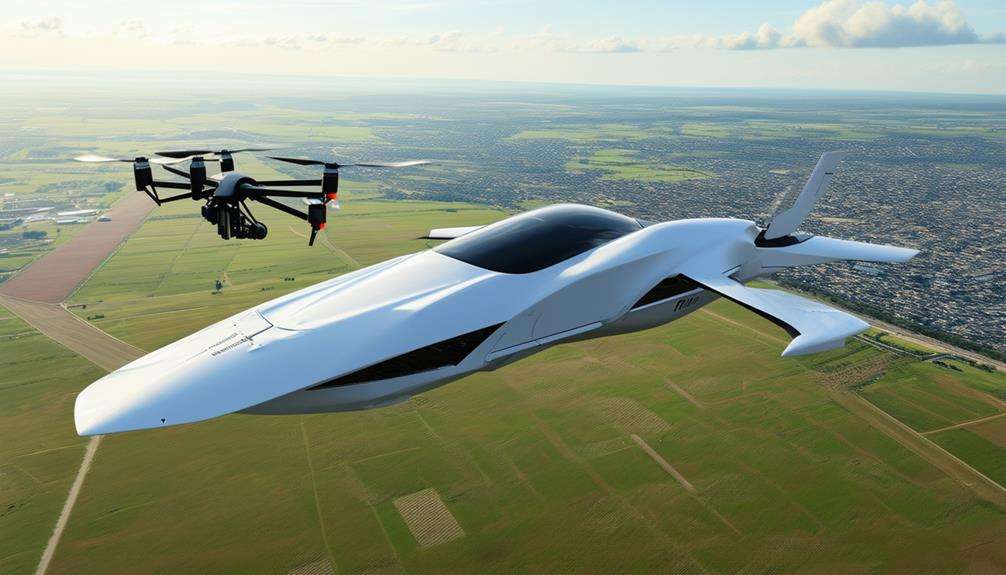
When evaluating operational efficiency, fixed-wing drones distinguish themselves through their extended flight durations and the ability to cover vast areas with minimal power consumption. These drones are highly energy-efficient, making them ideal for tasks that require extensive area coverage, such as aerial surveys and mapping. Their aerodynamic design enables prolonged gliding with minimal energy expenditure, making them perfect for long-duration flights over large expanses.
Conversely, rotary-wing drones, although less energy-efficient, offer unique advantages in different operational scenarios. They excel in maneuverability and hovering capabilities, making them suitable for tasks requiring close-proximity operations and rapid direction changes. Despite their shorter flight durations compared to fixed-wing drones, rotary-wing drones are indispensable for applications needing stability and precision, such as aerial photography and inspections.
Use Cases and Applications
When evaluating the operational efficiency of fixed-wing and rotary-wing drones, it's evident that each excels in specific applications. Fixed-wing drones are optimal for tasks requiring extensive area coverage swiftly and efficiently. They're particularly effective in aerial mapping, agriculture, and long-range surveillance due to their endurance and stability. These drones can remain airborne for extended periods, making them ideal for large-scale surveys and mapping missions.
Conversely, rotary-wing drones, including single rotor types, are well-suited for scenarios demanding precision and agility. They're perfect for aerial photography, detailed inspections, and tasks requiring hovering capability. Their ability to take off and land vertically enhances their versatility, especially in confined spaces or uneven terrains.
Both types of drones leverage advanced UAV technology to fulfill their roles effectively. When deciding between these drone types, consider their strengths in specific applications:
- Fixed-wing drones: Best for surveying, large-scale mapping, and long-range surveillance.
- Rotary-wing drones: Ideal for close-quarters navigation, aerial photography, and detailed inspections.
- Single rotor drones: Offer the endurance of fixed-wing drones and the agility of rotary-wing drones for specialized tasks.
Understanding these applications helps you choose the right drone for your specific needs.
Cost Considerations
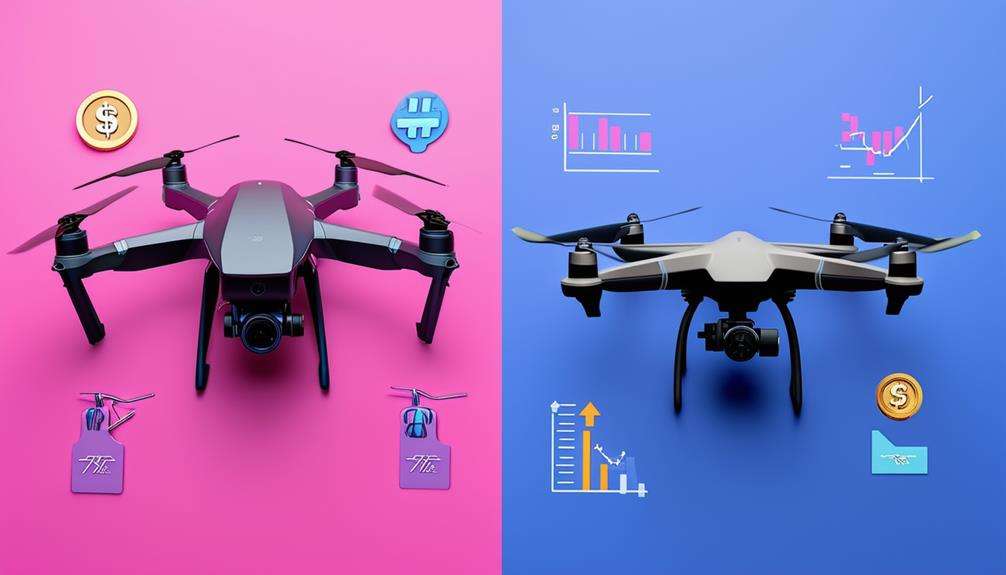
When choosing between fixed-wing and rotary-wing drones, it's important to consider both the purchase and ongoing maintenance costs. Fixed-wing drones generally have higher initial costs due to their complex design and larger size, making them a significant investment, especially for high-end models with advanced features. In contrast, rotary-wing drones are typically more affordable initially, making them accessible to a broader range of users, from hobbyists to professional operators.
However, initial costs are just one part of the equation. Maintenance costs for fixed-wing drones tend to be higher due to their intricate systems and specialized care requirements. While rotary-wing drones might seem cheaper to maintain at first, they often require more frequent repairs and parts replacements, which can quickly add up, impacting long-term cost considerations.
Operational expenses are another critical factor. Fixed-wing drones usually have longer flight times and can cover larger areas, potentially reducing operational expenses over time. Conversely, rotary-wing drones, although versatile, may incur higher operational costs due to their shorter flight times and higher energy consumption.
Maintenance and Durability
Maintaining and ensuring the durability of your drone is essential for optimal performance and longevity. Fixed-wing drones typically require less maintenance due to their simpler design with fewer moving parts. These drones are generally more resistant to damage from rough landings or crashes, making them quite robust. Nonetheless, they still require proper upkeep to ensure they last.
In contrast, rotary-wing drones, such as multirotors, need more frequent inspections. With multiple motors and propellers, there are more components that can wear out or become damaged. This makes them more delicate and prone to issues, necessitating careful handling and regular maintenance. Extending the lifespan of your rotary-wing drone involves diligently performing these checks and repairs.
To maintain your drone effectively, adhere to these tips:
- Regular Inspections: Frequently check your drone for any signs of wear, tear, or damage.
- Clean Components: Keep all moving parts free of dust and debris to avoid operational issues.
- Follow Manufacturer Guidelines: Adhere to the maintenance schedule and guidelines provided by the manufacturer.
With proper maintenance, both fixed-wing and rotary-wing drones can offer reliable service and extended durability.
Choosing the Right Drone
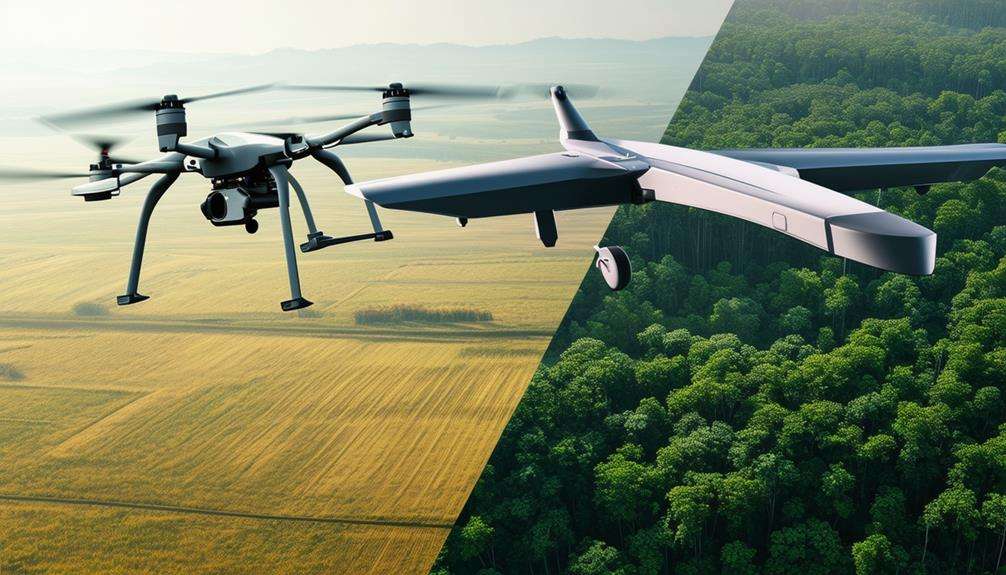
When selecting the appropriate drone, it's essential to align your choice with the specific needs of your mission and the operational environment. Begin by considering your mission requirements. If your task demands long endurance and the ability to cover vast distances, fixed-wing drones are ideal. Conversely, if maneuverability and the ability to hover are critical, rotary-wing drones will better suit your needs.
Next, evaluate the operational environment. Fixed-wing drones perform well in windy conditions due to their inherent stability, while rotary-wing drones excel in confined spaces, thanks to their vertical takeoff and landing capabilities. Your choice should be informed by the environment in which you'll be operating.
Assess your payload needs. Fixed-wing drones typically offer higher capacity for carrying sophisticated equipment, making them suitable for complex missions. In contrast, rotary-wing drones are better suited for lightweight payloads, offering versatility for various applications.
Conclusion
When choosing between fixed-wing and rotary-wing drones, consider your specific needs and project requirements. Fixed-wing drones are highly efficient for long-distance missions due to their aerodynamic design, making them ideal for tasks like large-scale mapping.
On the other hand, rotary-wing drones provide superior maneuverability, making them perfect for close-quarters tasks such as detailed inspections. Evaluate flight capabilities, operational efficiency, and maintenance needs to determine the best fit. Ultimately, the right drone will depend on the nature of your application. Make an informed decision to achieve optimal results for your project.

